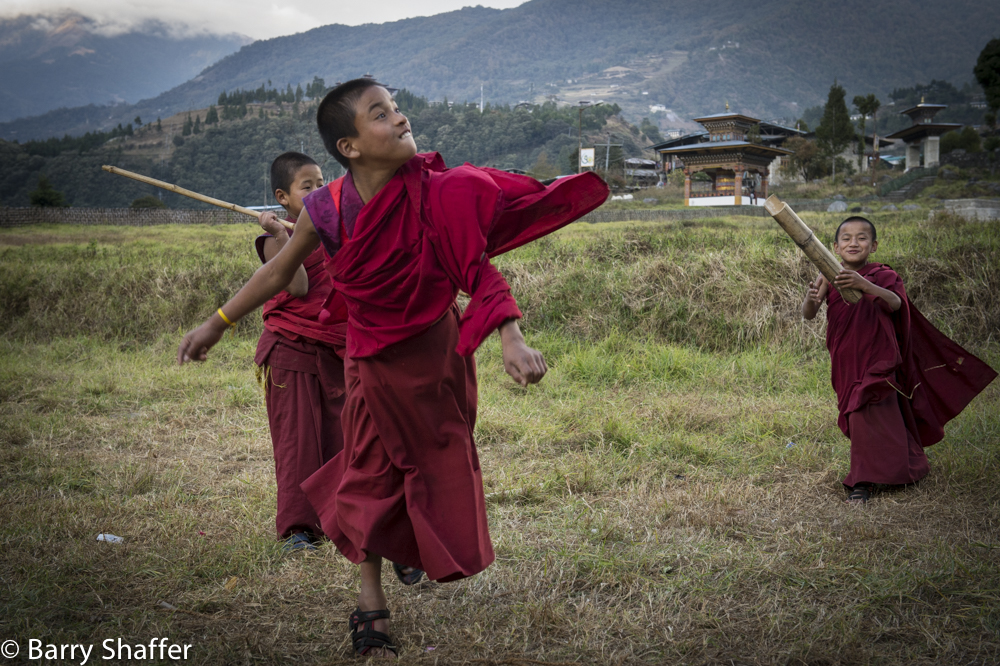We departed from our hotel in Trashigang in the early morning and headed into town to visit the Trashigang Dzong, built in 1659. Dzongs serve as the administrative and religious center in each district of Bhutan. Our guide Jigme Reegyal and our driver Pemba slung white scarves across their shoulders like sashes and explained that in Bhutan these serve as suit and tie. Citizens wore white scarves, monks wore red, ministers wore orange and the king wore a unique yellow scarf whenever he was in public. Young monks walked around the dzong as Bhutanese laborers made renovations to the ancient architecture. Barry and Jigme snapped photographs and the younger monks crowded around them to see pictures of themselves.
We returned to the car and set out for our homestay in the Trashiyangste district. We stopped at Gomphu Kora, a beautiful temple built in the 8th century with a picturesque setting above the Gamri river. A monk brought us clock-wise around the grounds and showed us the large black rock where Guru Rinpoche, an 8th century Buddhist master who is responsible for bringing Buddhism to Bhutan, meditated and left a body imprint in a rock. As we circled the rock Jigme told us stories of Guru Rinpoche’s battle with a demon shaped like a serpent and pointed out marks and impressions in the rock believed to have been made in that very battle. When the Guru finally subdued the demon, he made an agreement with the serpent to stay away and they sealed their deal with a thumbprint which made a deep groove in the rock. Jigme touched the groove with his thumb and pressed his thumb between his eyebrows.
We continued along the river until we reached Trashiyangste, our destination for the night. We pulled over to photograph young monks playing a game called Sok Sum in which they attempted to hit a piece of wood with long bamboo reeds (pictured above). While there we walked around Chorten Kora, an important stupa built in the 18th century by the nephew of Ngawang Namgyal, a Tibetan Buddhist lama responsible for unifying Bhutan as a nation and creating the unique Bhutanese cultural identity.

Stupas are spiritual monuments that quite literally blanket the landscape of Bhutan. We passed hundreds of small stupas on our drive through the east, and saw many more in the distant mountains. They are modeled after the eight mounds under which the ashes of the first Buddha were buried. Each time we pass a stupa, Pemba drives around it in a clockwise circle to gain merit and ensure our continuing safe passage. At the stupa in Trashiyangste, dozens of people circled clockwise, spinning prayer wheels and chanting.
When we finally arrived at our destination for the evening, a farmhouse called Choten Dendup, we met our host Tsiri and learned that we were only the second group of tourists to ever stay there. Tsiri and his wife served us locally grown red rice as well as carrots, brocolli and dried beef that tasted and felt like thick beef jerkey. Jigme brought me to my bed in the family’s altar room. “You’re lucky because this room is very special,” he said before informing me that I would be woken up at 7AM when Tsiri came in to make the family’s daily offerings and pray.

After dinner we were offered local wine, served hot and called Fire Water, and Tsiri cracked open large bottles of Bhutanese beer with red labels that read “Druk 1100, Super Strong Beer.” Super strong they were, and we sat around the table laughing and sharing stories translated by Jigme. Tsiri asked Barry why he had blue eyes and blonde hair, told me that if I married his son the entire village would have a festival for me and then convinced us to FaceTime with him.
At the end of the night Tsiri asked us “why, if you have so many luxuries at home, would you come all the way to Bhutan and sleep in a farmhouse?” Jigme responded for us. “In America people have luxuries, but they come to Bhutan to find joy. And why are you looking at what they have and craving what you do not? We wake up every morning and breathe the freshest air. We fall asleep every night and hear the dogs barking. No one else is so fortunate.” Tsiri agreed that he would not rather live in America, or even in Bhutan’s capital city of Thimpu, and that he was happiest in his village where he could work and where he had his family. I’m sure I misquoted Jigme here, but I went to bed that night listening to the dogs howling outside of my window and I felt very lucky to be in Bhutan.
Book your own adventure to Bhutan with Yangphel Adventure Travel

your trip sounds fascinating and inspring, I Love you two for all that you do and for sharing with us experiences we would never know about.
Keep sharing, just don’t come back with Monk Robes on, Ha ha !!!!
xoxo
LikeLike
Hearing your host decide that where he lives is where he wants to be, makes me happy. What a good lesson indeed.
Love the stories and images!
LikeLike
Just awesome!!! I don’t want to make you jealous but today I reconcile a dozen different checking accounts 🙂
LikeLike